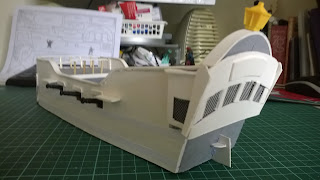Based on the rigging schematics in Part 2 I used elastic cord for the rigging. The reason for this will become apparent below, but in any case it will enable you to make some nice and tight lines. All the standing rigging is in black, as it is supposed to be. Standing rigging did not need to move and was tarred for durability. Running rigging, used to hoist and manipulate sails, needed to be flexible and was therefore not tarred and hemp-coloured. Failing to find light brown elastic cord, I forewent this difference.
Take care not to glue in place anything else. The tension on the cord is quite sufficient to hold masts and yardarms in place without glue or other attachments.
Below are some details of how the cord runs through the holes and how the sails have been furled and sowed in place. I really wanted to add sails, but decided for furled sails to be able to easily reacht the deck during play.
A learing point below: you will see how the stays bend over the railing. I should have attached the knotting point higher up, so that the stays would clear the railing while running upwards.
I made several flags for the Reaper, so I could sail her as a pirate ship, a privateer and a British Navy ship.
Glueing bits of plastic tube to the masttops enables me to easily switch flags.
Some last paint touch-ups, finishing the figurehead and the nameplate on the stern and here she is: finished for as much as I want to finish her before the first game: HMS Reaper and crew!
The finished figurehead.
Some additional freehand on the nameplate.
And now the final test and the reason I used elastic cord for the rigging. When you remove all the loose parts you can pull the masts out of their sockets as the cord gives way and fold the entire rigging back for easy storage and transport. A trick I read somewhere and gratefully borrowed for this project!
And just as easily he is put back in order again!
Arr me mateys! Hoist the mainsail! Battle stations! The Reaper is coming!















































